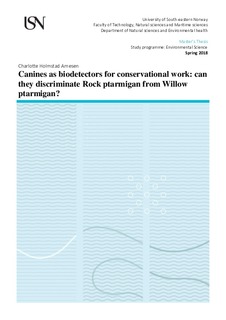| dc.contributor.author | Arnesen, Charlotte Holmstad | |
| dc.date.accessioned | 2018-12-14T09:03:47Z | |
| dc.date.available | 2018-12-14T09:03:47Z | |
| dc.date.issued | 2018 | |
| dc.identifier.uri | http://hdl.handle.net/11250/2577679 | |
| dc.description.abstract | The main goals for conservation biology is to document the full range of biological diversity and human impact, along with developing plans, approaches and measures to prevent extinction of species. Alpine and arctic bird populations have shown an unmistakable decrease in the last three decades, whereas the Rock ptarmigan (Lagopus muta) and Willow ptarmigan (L. lagopus) appear to have experienced one of the most severe decline, which have placed the respective species on the Norwegian “red list for threatened species” and in addition the Rock ptarmigan on the European red list in the category: “Near threatened”. In this study, the potential use of four privately owned dogs (Canis lupus familiaris) as a non-invasive conservational tool to determine the presence or absence of Rock ptarmigan through sniffing out fecal pellets (N=210) collected in 32 different areas in Norway and Sweden in laboratory conditions was investigated. I hypothesized that dogs could recognize fecal pellets from the Rock ptarmigan and discriminate it from other bird species in the Tetraonidae family (Black grouse (Tetrao Tetrix), Western capercaillie (T. urogallus) and Willow ptarmigan). I predicted that dogs would do a trained final response and lay down in front of the fecal pellets from the Rock ptarmigan if present and return to handler when absent. I showed that dogs can detect odor differences between the two avian species with an average accuracy of 66%, sensitivity of 67% and specificity of 65%. The result revealed a considerable range between the poorest and strongest performing dog in sensitivity (33% and 94%), specificity (44% and 89%) and accuracy (61% and 81%,). Looking at the result through a system consisting of four dogs, where > three dogs were required to perform an equal response on an arbitrarily sample for it to be considered a valid evaluation, we were able to reduce the cost of species identification through DNA-analysis by 55.6%. The result in this study demonstrates that dogs can be trained to recognize fecal pellets from the Rock ptarmigan and discriminate it from other similar species. The system approach can serve as an additional tool to fecal analysis providing management and researchers with information about the endangered species. | nb_NO |
| dc.language.iso | eng | nb_NO |
| dc.publisher | University of Southeast Norway | nb_NO |
| dc.subject | conservation biology | nb_NO |
| dc.subject | rock ptarmigan | nb_NO |
| dc.subject | willow ptarmigan | nb_NO |
| dc.subject | detection dogs | nb_NO |
| dc.title | Canines as biodetectors for conservational work: can they discriminate Rock ptarmigan from Willow ptarmigan? | nb_NO |
| dc.type | Master thesis | nb_NO |
| dc.description.version | publishedVersion | nb_NO |
| dc.rights.holder | Copyright The Author | nb_NO |
| dc.subject.nsi | VDP::Matematikk og Naturvitenskap: 400::Zoologiske og botaniske fag: 480 | nb_NO |
| dc.subject.nsi | VDP::Matematikk og Naturvitenskap: 400::Zoologiske og botaniske fag: 480::Økologi: 488 | nb_NO |
